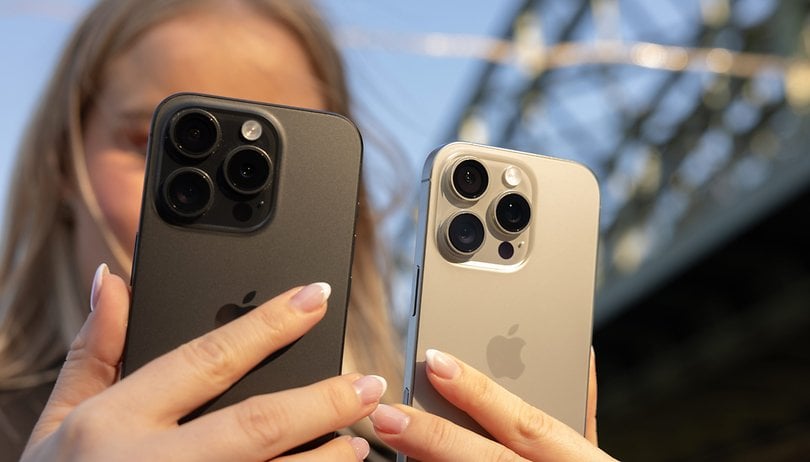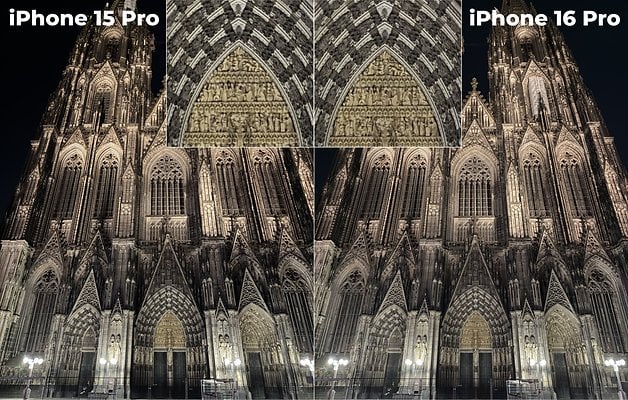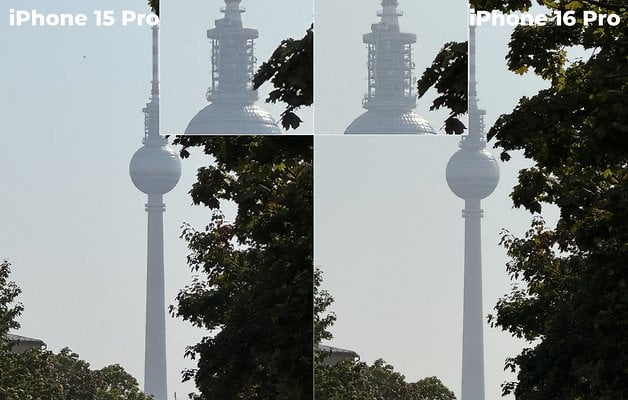iPhone 16 Pro vs 15 Pro: How Much Better (or Worse?) is the New Camera


On September 9, Apple spoke for almost 99 minutes about two new Watches, two AirPods, and—of course—the four new iPhones. A whopping 14 minutes of that evening were devoted to the new camera in the iPhone 16 Pro alone. But what has actually improved here? We take a look at the new hardware and show you where the new camera has improved—and where it's even worse.
Let's start with a look at the data sheet. Like its predecessor, the iPhone 16 Pro has three cameras: Ultra-wide-angle, main, and telephoto. However, there are two new features here compared to the iPhone 15 Pro.
- Apple has extended the telephoto camera from 3x to 5x—i.e. from 77 to 120 mm focal length.
- Apple has increased the resolution of the ultra-wide-angle camera from 12 to 48 megapixels.
This results in the following setup:
| Apple iPhone 15 Pro | Apple iPhone 16 Pro | |
|---|---|---|
| Ultra wide angle | 0.5x - 13 mm 12 megapixel f/2.2 |
0.5x - 13 mm 48 megapixel f/2.2 |
| Main camera | 1x - 24 mm 48 megapixel f/1.78 |
1x - 24 mm 48 megapixel f/1.78 |
| Telephoto camera | 3x - 77 mm 12 megapixel f/2.8 |
5x - 120 mm 12 megapixel f/2.8 |
There are two ways of looking at the effect of the changes: practically and theoretically. We start with the latter, but of course we also check our assumptions in practice with test photos.
From the technical data, two points in particular have a major impact on image quality:
- The size of the built-in image sensor: The larger the image sensor, the more light or data it captures. More data means a more accurate result and therefore better image quality.
- The resolution of the sensor: The higher the resolution, the finer details the sensor can capture.
When switching through the different focal lengths or zoom levels, the smartphone always accesses the most suitable sensor—and may have to digitally zoom into the images. In terms of resolution, a direct comparison between the iPhone 15 Pro and iPhone 16 Pro looks like this.

At ultra-wide angle, the iPhone 16 Pro now has a clear resolution advantage with 48 megapixels. If you zoom in a little—for example from 0.5x to 0.8x, the phone selects a section from the center of the ultra-wide-angle sensor for the photo—and the effective resolution drops.
At a focal length of 24 mm—i.e. 1x—both iPhones switch to the main camera and each have 48 megapixels available again. Digital zooming then behaves identically until shortly before "3x": the resolution drops.
However, the iPhone 15 Pro switches to the 3x telephoto sensor at 77 mm and thus has 12 megapixels available again. The iPhone 16 Pro, on the other hand, still has to "endure" up to 5x or 120 mm—and at "4.9x" generate the photos from a small center section from the main camera sensor, which still has a resolution of just 2 megapixels.
Of course, at focal lengths of 120 mm and above, the game is reversed and the iPhone 16 Pro is clearly ahead again.
A very similar picture emerges when looking at the sensor sizes. The iPhone 16 Pro shows an enormous gap in the focal length range between the main camera and the 5x telephoto camera.

iPhone 16 Pro vs iPhone 15 Pro in a practical test: Which phone has the better camera?
In order to confirm—or refute—the behavior described above, we have to go out and take pictures of ourselves in Berlin and Cologne.
Just for the sake of completeness: In order to exclude individual outliers, we always photograph each of these pictures three times and then select the best one afterwards. We also took photos with both iPhone models with the standard settings and in 12 megapixels.
Motif 1: Cologne Cathedral at night
Let's start with a challenge right away. Cologne Cathedral offers numerous fine details, and to capture these well at night, the two iPhones have to make the most of the residual light. We photographed through the following zoom levels: 0.5x, 1x, 2, 3x and 5x.
Motif 2: Television tower in Berlin
Admittedly, the second motif no longer holds any surprises. Our zoom series from 3x to 10x with the Berlin TV tower by day shows the same picture again. The iPhone 15 Pro delivers more detail at 3x, from 5x the iPhone 16 Pro is stronger. And of course the new iPhone model is also ahead at 10x.
Motif 3: Cross spider in macro
One last point concerns the ultra-wide-angle camera, which the iPhone traditionally uses to take macro photos. Even though the image sensor has not changed in size, the resolution has quadrupled. But what use is that in practice?
According to first impressions, unfortunately not very much. In direct comparison, the photo from the iPhone 16 Pro appears clearer and less noisy than that of the iPhone 15 Pro. However, in our macro series of at least five shots of this spider, we did not manage to tease out a sharper image from the new Pro iPhone.
Yes, in addition to pure photography, there are other aspects in which the iPhone 16 Pro differs from the iPhone 15 Pro. For example, Apple promises to have sped up the sensor of the main camera—and indeed, the shutter lag is noticeably shorter on the new Pro iPhone. And I'm not even going to mention the many new video features here. We will dedicate a separate article to them.
- More on the topic: Apple iPhone 16 Pro and iPhone 15 Pro in comparison
What do you think of the new camera in the iPhone 16 Pro: Do you prefer the new 5x zoom or would Apple have preferred to stick with the 3x lens? Or are you like me and can't understand why Apple doesn't just finally include both 3x and 5x in its Pro series?




























I saw your article on the 15 pro max camera as well.
It’s the same situation and I returned my preordered 16 pro max when comparing its photos to my 15 pro at 3x zoom. So I upgraded to the 15 pro with more storage instead. I am not settling for dramatically poor image quality at a zoom range that is used often. Maybe the iPhone 17 pro will not neglect. But regarding product hype I found the M4 iPad Pro Display lacking in color fidelity to the M2 12.9” pro and only improved with a the digital color filter. So what is popular opinion as to what is an improvement doesn’t always hold true. Thanks for shedding light on what is apparently true but often overlooked by abundant distraction.